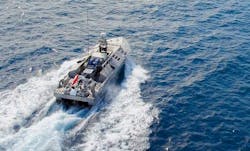Navy asks Textron to build another unmanned surface vessel for mine warfare in large open-ocean areas
WASHINGTON – U.S. Navy unmanned surface vessel (USV) experts are ordering an additional quickly deployable fast-moving unmanned boat to clear large ocean areas of sea mines that could threaten aircraft carrier battle groups, commercial ship traffic, and other ocean assets.
Officials of the Naval Sea Systems Command in Washington announced a $13 million order late last week to the Textron Systems Corp. Autonomy & Control Systems segment in Hunt Valley, Md., for an additional low rate initial production unit of the Unmanned Influence Sweep System (UISS) unmanned patrol boat.
The UISS is one of the counter-mine warfare systems that will enable the Navy littoral combat ship to perform mine warfare sweep missions. UISS will target acoustic, magnetic, and magnetic and acoustic combination mine types only. The UISS program provides rapid wide-area mine clearance to neutralize magnetic and acoustic sea mines in a small, lightweight package.
The UISS uses the Textron Common Unmanned Surface Vessel (CUSV), which will travel aboard the LCS and deploy as necessary to detect, pinpoint, and trigger explosive sea mines hidden under the surface intended to damage or destroy surface warships or commercial shipping.
The system consists of the CUSV unmanned power boat that tows an acoustic and magnetic minesweep system that emits acoustic and magnetic signals that provide a false signature that triggers mines. The surface vessel operates far enough away so that it will not be damaged by a detonating mine, Navy officials say.
The UISS uses the Navy's Multiple Vehicle Communications System (MVCS) aboard the LCS, which handles communications between the LCS surface ship and different mission packages, including the UISS, that involve mine countermeasures, anti-submarine warfare, and surface warfare.
For the MVCS the Navy is using the AB3100H embedded computer from Astronics Ballard Technology in Everett, Wash. The AB3100H rugged computer is part of the company's AB3000 line of small, lightweight embedded computers with the Intel E680T processor, MIL-STD-1553 and ARINC 429/708/717 interfaces, Ethernet, USB, video, audio, and PMC expansion.
The AB3000 series from Astronics Ballard Technology comes with factory-installed PCI mezzanine card (PMC) modules that enable designers to add an Ethernet switch, synchronous and asynchronous serial interfaces, and isolated double-throw relays.
Related: Pentagon gets serious about unmanned surface vessels
The Textron CUSV and its unmanned maritime command and control station use a modular architecture that accommodates platform reconfiguration and interchangeable payloads.
This CUSV unmanned boat can handle mine warfare; anti-submarine warfare; communications relay; intelligence, surveillance and reconnaissance; anti-surface warfare; and UAS/UUV launch and recovery missions.
On this order Textron will do the work in Hunt Valley, Md., and Slidell, La., and should be finished by September 2022. For more information contact Textron Unmanned Systems online at www.textronsystems.com, Astronics Ballard Technology at www.astronics.com, or Naval Sea Systems Command at www.navsea.navy.mil.
About the Author
John Keller
Editor-in-Chief
John Keller is the Editor-in-Chief, Military & Aerospace Electronics Magazine--provides extensive coverage and analysis of enabling electronics and optoelectronic technologies in military, space and commercial aviation applications. John has been a member of the Military & Aerospace Electronics staff since 1989 and chief editor since 1995.
